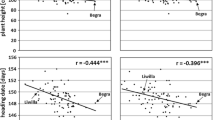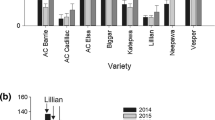Abstract
Septoria tritici blotch (STB), caused by Zymoseptoria tritici (synonyms: Mycosphaerella graminicola and Septoria tritici), is a devastating disease of wheat (Triticum aestivum L.) worldwide. STB can be managed by fungicide application and by host resistance. The use of fungicides is less effective due to the development of fungal populations resistant to commercially available fungicides. As a result, host plant resistance is considered as one of the best strategies of STB management. In our preliminary study, the spring wheat cultivar ‘Largo’ showed a high level of resistant to multiple isolates of Z. tritici. The main objective of this study was to identify quantitative trait loci (QTL) for STB resistance in Largo and DNA markers associated with QTL. The 118 F7 recombinant-inbred lines were developed from a cross between the synthetic hexaploid wheat Largo and the spring wheat susceptible line ND495 by single-seed descent. Disease severity in the mapping population was assessed at flag leaf stage 21 days after inoculation in the greenhouse at North Dakota State University, Fargo, ND in 2009 and 2010. Approximately, 2500 Diversity Arrays Technology® (DArT) markers were used for genetic mapping. Among them, 263 DArT markers were polymorphic and revealed the 37 linkage groups. The new putative QTL (QStb.2A) associated with STB resistance was flanked by the two DArT markers wPt_3896 and wPt_4197, (wPt_4555) and is mapped on chromosome 2A. Single marker analysis also detected three additional DArT markers associated with other QTLs; however, chromosomal locations of these markers are unknown. Our results indicated that the DArT markers identified in this study can be useful for marker-assisted selection in wheat breeding programs and for combing this novel QTL with other STB resistance genes.



Similar content being viewed by others
References
Adhikari TB, Anderson JM, Goodwin SB (2003) Identification and molecular mapping of a gene in wheat conferring resistance to Mycosphaerella graminicola. Phytopathology 93(9):1158–1164
Adhikari T, Yang X, Cavaletto J, Hu X, Buechley G, Ohm H, Shaner G, Goodwin S (2004a) Molecular mapping of Stb1, a potentially durable gene for resistance to Septoria tritici blotch in wheat. Theor Appl Genet 109(5):944–953
Adhikari TB, Cavaletto JR, Dubcovsky J, Gieco JO, Schlatter AR, Goodwin SB (2004b) Molecular mapping of the Stb4 gene for resistance to Septoria tritici blotch in wheat. Phytopathology 94(11):1198–1206
Adhikari TB, Wallwork H, Goodwin SB (2004c) Microsatellite markers linked to the Stb2 and Stb3 genes for resistance to Septoria tritici blotch in wheat. Crop Sci 44(4):1403–1411
Akbari M, Wenzl P, Caig V, Carling J, Xia L, Yang S, Uszynski G, Mohler V, Lehmensiek A, Kuchel H (2006) Diversity arrays technology (DArT) for high-throughput profiling of the hexaploid wheat genome. Theor Appl Genet 113(8):1409–1420
Arraiano L, Brown J (2006) Identification of isolate-specific and partial resistance to Septoria tritici blotch in 238 European wheat cultivars and breeding lines. Plant Pathol 55(6):726–738
Arraiano L, Worland A, Ellerbrook C, Brown J (2001) Chromosomal location of a gene for resistance to Septoria tritici blotch (Mycosphaerella graminicola) in the hexaploid wheat’Synthetic 6x’. Theor Appl Genet 103(5):758–764
Arraiano L, Chartrain L, Bossolini E, Slatter H, Keller B, Brown J (2007) A gene in European wheat cultivars for resistance to an African isolate of Mycosphaerella graminicola. Plant Pathol 56(1):73–78
Brading PA, Verstappen EC, Kema GH, Brown JK (2002) A gene-for-gene relationship between wheat and Mycosphaerella graminicola, the Septoria tritici blotch pathogen. Phytopathology 92(4):439–445
Camacho-Casas M, Kronstad W, Scharen A (1995) Septoria tritici resistance and associations with agronomic traits in a wheat cross. Crop Sci 35(4):971–976
Cavanagh CR, Chao S, Wang S, Huang BE, Stephen S et al (2013) Genome-wide comparative diversity uncovers multiple targets of selection for improvement in hexaploid wheat landraces and cultivars. Proc Nat Acad Sci USA 110:8057–8062
Chartrain L, Berry S, Brown J (2005a) Resistance of wheat line Kavkaz-K4500 L. 6. A. 4 to Septoria tritici blotch controlled by isolate-specific resistance genes. Phytopathology 95(6):664–671
Chartrain L, Brading P, Brown J (2005b) Presence of the Stb6 gene for resistance to Septoria tritici blotch (Mycosphaerella graminicola) in cultivars used in wheat breeding programmes worldwide. Plant Pathol 54(2):134–143
Chartrain L, Joaquim P, Berry S, Arraiano L, Azanza F, Brown J (2005c) Genetics of resistance to Septoria tritici blotch in the Portuguese wheat breeding line TE 9111. Theor Appl Genet 110(6):1138–1144
Chartrain L, Sourdille P, Bernard M, Brown J (2009) Identification and location of Stb9, a gene for resistance to Septoria tritici blotch in wheat cultivars Courtot and Tonic. Plant Pathol 58(3):547–555
Chu C-G, Chao S, Friesen T, Faris J, Zhong S, Xu S (2010) Identification of novel tan spot resistance QTLs using an SSR-based linkage map of tetraploid wheat. Mol Breeding 25(2):327–338
Cools HJ, Fraaije BA (2008) Are azole fungicides losing ground against septoria wheat disease? resistance mechanisms in Mycosphaerella graminicola. Pest Manag Sci 64(7):681–684
Crossa J, Burgueno J, Dreisigacker S, Vargas M, Herrera-Foessel SA, Lillemo M, Singh RP, Trethowan R, Warburton M, Franco J (2007) Association analysis of historical bread wheat germplasm using additive genetic covariance of relatives and population structure. Genetics 177(3):1889–1913
Drabešová J, Ryšánek P, Brunner P, McDonald BA, Croll D (2013) Population genetic structure of Mycosphaerella graminicola and Quinone Outside Inhibitor (QoI) resistance in the Czech Republic. Eur J Plant Pathol 135(1):211–224
Eriksen L, Borum F, Jahoor A (2003) Inheritance and localisation of resistance to Mycosphaerella graminicola causing Septoria tritici blotch and plant height in the wheat (Triticum aestivum L.) genome with DNA markers. Theor Appl Genet 107(3):515–527
Eyal Z (1999) The Septoria tritici and Stagonospora nodorum blotch diseases of wheat. Eur J Plant Pathol 105(7):629–641
Eyal Z, Scharen AL, Prescott JM, Van Ginkel M (1987) The septoria diseases of wheat: concepts and methods of disease management. CIMMYT, Mexico
Ghaffary SMT, Robert O, Laurent V, Lonnet P, Margalé E, van der Lee TA, Visser RG, Kema GH (2011) Genetic analysis of resistance to Septoria tritici blotch in the French winter wheat cultivars Balance and Apache. Theor Appl Genet 123(5):741–754
Ghaffary SMT, Faris JD, Friesen TL, Visser RG, van der Lee TA, Robert O, Kema GH (2012) New broad-spectrum resistance to Septoria tritici blotch derived from synthetic hexaploid wheat. Theor Appl Genet 124(1):125–142
Goudemand E, Laurent V, Duchalais L, Ghaffary SMT, Kema GH, Lonnet P, Margalé E, Robert O (2013) Association mapping and meta-analysis: two complementary approaches for the detection of reliable Septoria tritici blotch quantitative resistance in bread wheat (Triticum aestivum L.). Mol Breeding 32(3):563–584
Gurung S, Goodwin SB, Kabbage M, Bockus WW, Adhikari TB (2011) Genetic differentiation at microsatellite loci among populations of Mycosphaerella graminicola from California, Indiana, Kansas, and North Dakota. Phytopathology 101(10):1251–1259
Gurung S, Hansen JM, Bonman JM, Gironella AIN, Adhikari TB (2012) Multiple disease resistance to four leaf spot diseases in winter wheat accessions from the USDA National Small Grains Collection. Crop Sci 52(4):1640–1650
Gurung S, Mamidi S, Bonman JM, Xiong M, Brown-Guedira G, Adhikari TB (2014) Genome-wide association study reveals novel QTL associated with resistance to major foliar pathogens in spring wheat landraces. PLoS One 9(9):e108179
Joehanes R, Nelson JC (2008) QGene 4.0, an extensible Java QTL-analysis platform. Bioinformatics 24(23):2788–2789
Joppa L, Williams N (1982) Registration of Largo, a greenbug resistant hexaploid wheat1 (Reg. No. GP 176). Crop Sci 22(4):901–902
Kelm C, Ghaffary SMT, Bruelheide H, Röder MS, Miersch S, Weber WE, Kema GH, Saal B (2012) The genetic architecture of seedling resistance to Septoria tritici blotch in the winter wheat doubled-haploid population Solitär × Mazurka. Mol Breeding 29(3):813–830
Kosambi D (1943) The estimation of map distances from recombination values. Ann Eugen 12(1):172–175
Liu Y, Zhang L, Thompson IA, Goodwin SB, Ohm HW (2013) Molecular mapping re-locates the Stb2 gene for resistance to Septoria tritici blotch derived from cultivar Veranopolis on wheat chromosome 1BS. Euphytica 190(1):145–156
McCartney C, Brûlé-Babel A, Lamari L, Somers D (2003) Chromosomal location of a race-specific resistance gene to Mycosphaerella graminicola in the spring wheat ST6. Theor Appl Genet 107(7):1181–1186
Mergoum M, Singh P, Ali S, Elias E, Anderson J, Glover K, Adhikari T (2007) Reaction of elite wheat genotypes from the northern Great Plains of North America to Septoria diseases. Plant Dis 91(10):1310–1315
Mergoum M, Harilal V, Singh P, Adhikari T, Kumar A, Ghavami F, Elias E, Alamri M, Kianian S (2013) Genetic analysis and mapping of seedling resistance to Septoria tritici blotch in ‘Steele-ND’/‘ND 735′ bread wheat population. Cereal Res Commun 41:199–210
Orton ES, Deller S, Brown JK (2011) Mycosphaerella graminicola: from genomics to disease control. Mol Plant Pathol 12(5):413–424
Quaedvlieg W, Kema GHJ, Groenewald JZ, Verkley GJM, Seifbarghi S, Razavi M, Gohari AM, Mehrabi R, Crous PW (2011) Zymoseptoria gen. nov.: a new genus to accommodate Septoria-like species occurring on graminicolous hosts. Persoonia 26:57–69
Raman R, Milgate A, Imtiaz M, Tan M-K, Raman H, Lisle C, Coombes N, Martin P (2009) Molecular mapping and physical location of major gene conferring seedling resistance to Septoria tritici blotch in wheat. Mol Breeding 24(2):153–164
Rosielle A, Brown A (1979) Inheritance, heritability and breeding behaviour of three sources of resistance to Septoria tritici in wheat. Euphytica 28(2):385–392
Shaner G, Finney RE (1976) Weather and epidemics of Septoria leaf blotch of wheat. Infection 5(6):8
Simon MR, Khlestkina EK, Castillo NS, Börner A (2010) Mapping quantitative resistance to Septoria tritici blotch in spelt wheat. Eur J Plant Pathol 128(3):317–324
Simón M, Ayala F, Cordo C, Röder M, Börner A (2004) Molecular mapping of quantitative trait loci determining resistance to Septoria tritici blotch caused by Mycosphaerella graminicola in wheat. Euphytica 138(1):41–48
Singh P, Mergoum M, Ali S, Adhikari T, Elias E, Hughes G (2006) Identification of new sources of resistance to tan spot, stagonospora nodorum blotch, and Septoria tritici blotch of wheat. Crop Sci 46(5):2047–2053
Torriani SF, Brunner PC, McDonald BA, Sierotzki H (2009) QoI resistance emerged independently at least 4 times in European populations of Mycosphaerella graminicola. Pest Manag Sci 65(2):155–162
Wilson R (1985) Inheritance of resistance to Septoria tritici in wheat. ARS-US Department of Agriculture Agricultural Research Service, Boca Raton
Acknowledgments
We gratefully acknowledge financial support from North Dakota Wheat Commission, and the State Board of Agricultural Research and Education, North Dakota, and USDA-ARS specific cooperative agreement 58-5366-0-133. We thank Steven Xu for providing the mapping population and Jana Hansen for technical help.
Author information
Authors and Affiliations
Corresponding author
Electronic supplementary material
Below is the link to the electronic supplementary material.
Rights and permissions
About this article
Cite this article
Adhikari, T.B., Mamidi, S., Gurung, S. et al. Mapping of new quantitative trait loci (QTL) for resistance to Septoria tritici blotch in spring wheat (Triticum aestivum L.). Euphytica 205, 699–706 (2015). https://doi.org/10.1007/s10681-015-1393-4
Received:
Accepted:
Published:
Issue Date:
DOI: https://doi.org/10.1007/s10681-015-1393-4




